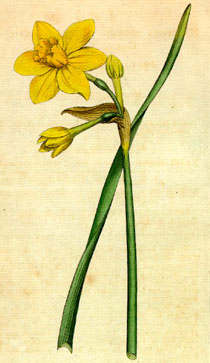Dorothy Wordsworth (1751-1855) was an engaged and engaging naturalist in her own right. Here she describes the spring flowers that would become the subject for perhaps her brother William‘s most famous poem: “When we were in the woods beyond Gowbarrow Park we saw a few daffodils close to the water side. We fancied that the lake had floated the seeds ashore and that the little colony had so sprung up. But as we went along there were more and yet more and at last under the boughs of the trees, we saw that there was a long belt of them [the end we did not see (erased)] along the shore, about the breadth of a country turnpike road. I never saw daffodils so beautiful they grew among the mossy stones about and about them, some rested their heads upon these stones as on a pillow for weariness and the rest tossed and reeled and danced and seemed as if they verily laughed with the wind that blew upon them over the lake, they looked so gay ever glancing ever changing” (Journal, 15 April 1802). It would take her poetic brother two years of imaginative effort to turn this wonderfully immediate natural description into “When all at once I saw a crowd, / A host, of golden daffodils.”
A careful critique of Dorothy’s passage reveals its riches. Dorothy’s recollection sounds initially like that of a natural historian: “The hawthorns are black and green, the birches here and there greenish but there is yet more of purple to be seen on the twigs . . . a few primroses by the roadside, wood-sorrel flower, the anemone, scentless violets, strawberries, and that starry yellow flower which Mrs. C. calls pile wort. When we were in the woods beyond Gowbarrow park we saw a few daffodils close to the water side” (my emphases 109). Then, in an important transitional sentence, Dorothy reveals her “fancy” going to work on these objects of nature: “We fancied that the lake had floated the seeds ashore and that the little colony had so sprung up. But as we went along there were more and yet more and at last under the boughs of the trees, we saw that there was a long belt of them [the end we did not see (erased)] along the shore, about the breadth of a country turnpike road” (109). Only at this moment does Dorothy launch into the poetic possibility that these flowers can be more closely linked to human emotions than we might think, even as she gives up on formal grammar and syntax: “I never saw daffodils so beautiful they grew among the mossy stones about and about them, some rested their heads upon these stones as on a pillow for weariness and the rest tossed and reeled and danced and seemed as if they verily laughed with the wind that blew upon them over the lake, they looked so gay ever glancing ever changing” (my emphases 109, 15 April 1802).
An earlier passage from Dorothy’s journal reveals a similar connection of wind-caused motion, animation, and the link between human emotion and the natural world. The scene takes place during a winter wind on Grasmere Lake. I quote the passage in its entirely because it so clearly reveals the rhetorical movement from inanimate images (wind on the water), to animate images (“peacock’s tail,” “they made it all alive”), to humanized emotion applied to a flower (“let it live if it can”):
We amused ourselves for a long time in watching the Breezes some as if they came from the bottom of the lake spread in a circle, brushing along the surface of the water, and growing more delicate, as it were thinner and of a paler colour till they died away. Others spread out like a peacock’s tail, and some went right forward this way and that in all directions. The lake was still where these breezes were not, but they made it all alive. I found a strawberry blossom in a rock. The little slender flower had more courage than the green leaves, for they were but half expanded and half grown, but the blossom was spread full out. I uprooted it rashly, and I felt as if I had been committing an outrage, so I planted it again. It will have but a stormy life of it, but let it live if it can” (82-3, 31 January 1802).
Dorothy’s sudden emotional response to a flower here reminds us of her brother’s pantheistic reaction to his own impulsive destruction of nature in “Nutting”: “I felt a sense of pain when I beheld / The silent trees and the intruding sky – / Then, dearest Maiden . . . with gentle hand / Touch, – for there is a Spirit in the woods” (ll. 50-52, 53-54). ~ (A.N.)

